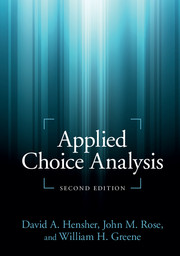Book contents
- Frontmatter
- Contents
- List of Figures
- List of Tables
- Preface
- Part I Getting started
- Part II Software and data
- Part III The suite of choice models
- Part IV Advanced topics
- 20 Frontiers of choice analysis
- 21 Attribute processing, heuristics, and preference construction
- 22 Group decision making
- Select glossary
- References
- Index
22 - Group decision making
from Part IV - Advanced topics
Published online by Cambridge University Press: 05 June 2015
- Frontmatter
- Contents
- List of Figures
- List of Tables
- Preface
- Part I Getting started
- Part II Software and data
- Part III The suite of choice models
- Part IV Advanced topics
- 20 Frontiers of choice analysis
- 21 Attribute processing, heuristics, and preference construction
- 22 Group decision making
- Select glossary
- References
- Index
Summary
Introduction
The literature on household economics has made substantial progress in the study of group decision making, beginning with the initial theoretical contributions (Becker 1993; Browning and Chiappori 1998; Lampietti 1999; Chiuri 2000; Vermeulen 2002), and subsequent empirical applications in various fields, such as marketing (Arora and Allenby 1999; Adamowicz et al. 2005), transport (Brewer and Hensher 2000; Hensher et al. 2007), and environmental economics (Quiggin 1998; Smith and Houtven 1998; Bateman and Munroe 2005; Dosman and Adamowicz 2006). Recent studies, for example, provide evidence of substantial differences in taste intensities between domestic partners, and make an attempt at reconciling them with observed joint choices using power functions (Dosman and Adamowicz 2006; Beharry et al. 2009). The evidence collected so far indicates that, for some categories of decisions, the conventional practice of selecting one member of the couple as representative of the tastes of the entire household may be biased when compared with the preference estimates underlying joint deliberation by the same couple.
Despite the existence of an extensive literature on group decision making, synthesized in Dellaert et al. (1998) and Vermuelen (2002), there has been a limited focus on ways in which multiple agents have been recognized in the formalization of discrete choice models. This literature can broadly be divided into two. (i) a focus on the game playing between agents in a sequential choice process that involves initial preferences (with or without knowledge of the agent’s choice), followed by a process of feedback, review, and revision or maintenance of the initial preference. This approach endogenizes the preferences of other decision makers in the ultimate group decision. We call this interactive agency choice experiments (IACE), as developed initially by Hensher and detailed in Brewer and Hensher (2000) and Rose and Hensher (2004). (ii) studies that develop ways of establishing the influence and power of each agent in the joint choice outcome, which may or may not use an IACE framework. Puckett and Hensher (2006) review this literature, which is primarily in marketing and household economics and has, for example, been extended and implemented in the study of freight distribution chains by Hensher et al. (2008), to the study of partnering between bus operators and the regulator by Hensher and Knowles (2007) and, most recently, to the household purchase of alternative fueled vehicles by Hensher et al. (2011) and Beck et al. (2012).
- Type
- Chapter
- Information
- Applied Choice Analysis , pp. 1072 - 1115Publisher: Cambridge University PressPrint publication year: 2015



